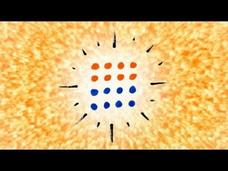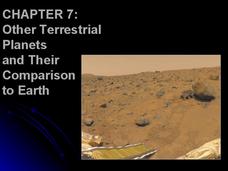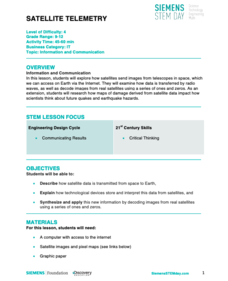Telescopes Teacher Resources
Find Telescopes lesson plans and worksheets
Showing 977 resources
University of Colorado
Astro-Chronology
Class members play a version of the game Chronology to determine when certain scientific events occurred in history. Teams play until someone has 5-10 events in the correct order.
University of Colorado
The Jovian Basketball Hoop
A radio receives radio signals, converts them to an electrical signal, then converts this signal to a sound signal, and amplifies the sound so people can hear it. Class members use this information to create a short-wave radio antenna...
University of Colorado
The Jovian Basketball Hoop
Can you listen to Jupiter on a simple radio? Turns out the answer is yes! The resource instructs scholars to build a simple radio to pick up the radio waves created when the charged particles from the sun hit Jupiter's magnetic...
MinutePhysics
Picture of the Big Bang (a.k.a. Oldest Light in the Universe)
Everyone knows the Big Bang Theory ... but, then what happened? Go beyond the bang in an illustrated video that discusses the after effects of the event that set our universe in motion. Physics scholars discover how the creation of...
MinutePhysics
A Polarizing Discovery About the Big Bang!
The Big Bang just got bigger! Learners explore the early universe in a short, animated video. The narrator guides viewers through the revelation that photons polarized by masses of plasma travel through space to bring us a...
Crash Course
Stars
Star light, start bright! What do the brightness and color of stars tell us about the stars we see at night? Learners explore the life of stars with an information-packed video. Topics include the relationship between mass and...
Crash Course
Binary and Multiple Stars
Twinkle, twinkle little star(s)? Many of the stars above us are not alone! The narrator in the video explains the delicate balance present in binary and multiple star systems. Pupils learn about stars that orbit one another—and even...
Crash Course
The Earth
Your fingernails grow at approximately the same rate Earth's continents move. The video discusses Earth as a planet, its layers, our magnetic field, the atmosphere, and the human impact on Earth. It provides interesting facts that...
Crash Course
Mercury
The most elliptical orbit of any planet belongs to Mercury. The video includes obvious facts about Mercury such as the hot temperature and lack of magnetic field. It also discusses highly surprising facts such as the cracks, ice, and...
University of Texas
Lives of Stars
Stars exist from a few million years to over 10 billion years, depending on their mass. Scholars perform a play acting as stars to learn about their different life cycles. They develop an understanding of many of the fundamental concepts...
Kurzgesagt – In a Nutshell
The Beginning of Everything—The Big Bang
How can something come from nothing? The Big Bang Theory has an answer to that question. An installment in the Kurzgesagt playlist outlines the theory of the origin of the universe. It includes an explanation of the evidence that...
Socratica
What Are White Dwarfs?
White dwarfs are stars that refuse to die. A video begins with an explanation of the three fates of dying stars. The presentation explains the composition and life expectancy of a typical white dwarf.
Socratica
What Are Neutron Stars?
What happens at the end of the life cycle of a star? A lesson in the Socratica Astronomy playlist shows three ways a star dies: white dwarf, black hole, and neutron star. Each ending depends on the mass of the original star.
Socratica
What Is Earthshine?
Light travels in interesting ways through the solar system. A video episode from a longer series highlights how the sun's rays travel to the earth and moon and sometimes in between. Scholars learn about reflection properties on a very...
SciShow
There's Going to Be a New Star in the Sky
There's something to look forward to in 2021 or 2022! Although the actual event occurred almost 2,000 years ago, the appearance of a new star will become evident from Earth in a few short years. The video instructor from the solar...
Glynn County School System
Terrestrial Planets
Mercury, Venus, Earth, and Mars are collectively known as the terrestrial planets. Although part of the same group, each planet has its own set of characteristics. Scholars explore the characteristics that make the planets unique and...
Glynn County School System
Light, History, Gravity, Distance, Relativity, and Space-Time
Let the star's color be the guide! The color of a star indicates its temperature and its mass and distance affect the gravitational force. The lesson presentations address these concepts as well as how the theory of special relativity...
Discovery Education
Satellite Telemetry
Satellites require rockets to launch, but it doesn't take a rocket scientist to understand them. Future engineers learn about how satellites send data to Earth and how to interpret satellite images. They see how radio waves play a role...
Florida Center for Reading Research
Comprehension: Monitoring for Understanding, What Do You Know?
An activity promotes reading comprehension. Readers analyze a text of their choice while activating prior knowledge and asking and answering questions. Scholars enforce multiple strategies to improve comprehension.
International Technology Education Association
Singin' the Black and Blues
How does the color of the sky change from blue to reds and oranges to black? An illuminating lesson explains how light travels through different mediums using the sun's light as an example. By examining diagrams and illustrations, pupils...
Thoughtful Learning
Setting and Reaching Goals
An activity boosts self-management through goal setting and reflection. Scholars choose one goal they wish to obtain by the end of the week. Participants brainstorm ways to make their goal a reality then reflect on whether or not their...
American Museum of Natural History
What is Astronomy?
Go study the universe. Pupils learn seven aspects about astronomy and astronomers. They begin to learn about constellations; distance and motion between objects; gravity; the electromagnetic spectrum; dark matter and energy; and teams of...
American Museum of Natural History
What Do You Know About Astronomy
Develop an understanding of the universe. Learners answer 10 multiple choice questions about several topics in astronomy. Questions contain information about the age of the universe, gravitational attraction, galaxies, planets and comets...
American Museum of Natural History
Planetary Mysteries
Get to know our little part of the vast universe. Learners read about the common and not-so-common facts about each of the planets in the solar system. The interactive lesson includes a large amount of information as well as a quiz to...
Other popular searches
- Space Telescopes
- Hubble Telescopes
- Compare Telescopes
- Optical Telescopes
- Reflecting Telescopes
- Making Telescopes
- Space Tools Telescopes
- Telescopes Distant Objects
- Telescopes Handout
- Optical and Radio Telescopes
- Convex Lenses and Telescopes
- Radio Telescopes

























